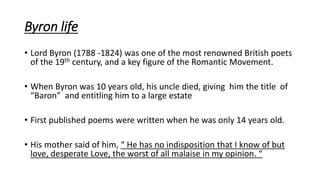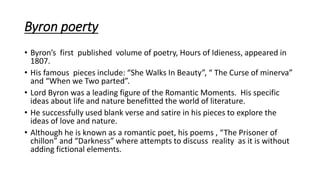Byron Major Work
- 2. âĒ Presented by : Sangita kantariya âĒ MA Sem : 01 âĒ Paper No : 103 literature of the Romantic âĒ Topic : Byron Major Work âĒ Roll No : 33 âĒ Submitted By : S.B.Gardi Department of English, MKBU
- 4. Byron life âĒ Lord Byron (1788 -1824) was one of the most renowned British poets of the 19th century, and a key figure of the Romantic Movement. âĒ When Byron was 10 years old, his uncle died, giving him the title of âBaronâ and entitling him to a large estate âĒ First published poems were written when he was only 14 years old. âĒ His mother said of him, â He has no indisposition that I know of but love, desperate Love, the worst of all malaise in my opinion. â
- 5. âĒ He was educated in Cambridge at Trinity College. âĒ He was a leading figure in Romanticism. âĒ When he was 21, he became a member of the House of Lordâs. âĒ Revolutionary British poet
- 6. Byron poerty âĒ Byronâs first published volume of poetry, Hours of Idieness, appeared in 1807. âĒ His famous pieces include: âShe Walks In Beautyâ, â The Curse of minervaâ and âWhen we Two partedâ. âĒ Lord Byron was a leading figure of the Romantic Moments. His specific ideas about life and nature benefitted the world of literature. âĒ He successfully used blank verse and satire in his pieces to explore the ideas of love and nature. âĒ Although he is known as a romantic poet, his poems , âThe Prisoner of chillonâ and âDarknessâ where attempts to discuss reality as it is without adding fictional elements.
- 7. âĒ The recurring theme in most of his pieces are natural, the folly of love, realism in literature, liberty and the power of art. âĒ Some his popular poems are: âShe Walks in Beautyâ, âDarknessâ, âThere Be None of Beautyâs Daughterâ, âThe Eve of waterlooâ, âWhen We Two partedâ and âAnd Thou Art Dead, as young and Fair.â
- 8. Lord Byron Impact on Future Literature âĒ Lord Byron unique literary ideas brought new perspectives for English literature. âĒ His distinctive writing approach and experimentation with epics and lyrics made him stand out even among the best poets. âĒ His narrative and lyrical works are regarded as masterpieces and had significant impacts on generation. âĒ He Successfully documented his ideas and feelings about historical tragedies and romanticism in his writings that even today, writers try to imitate his unique style, considering him a beacon for writings poetry.
- 9. Childe Haroldâs pilgrimage âĒ Byronâs first literary triumph âĒ In 1809 Byron started on a tour of Europe and orient. The poetic results of this trip were the first two cantos of Childe Haroldâs Pilgrimage, with their famous description of romantic scenery. âĒ The work made him instantly popular. As he says himself, âĒ â I awoke one morning to find myself famous,â and presently he styles himselfâ âĒ The worst element in Byron at this time was his insincerity, his continual posing as the hero of his poetry.
- 10. âĒ Published 1812-1818 âĒ Dedicated to Charlotte Harley âĒ Consists of 4 cantos âĒ The travels of a world â weary young man âĒ Chide âa young man who was a candidate for knighthood âĒ Colorful descriptions of exotic nature, a lyrical exaltation of freedom, lonely hero
- 11. Don juan âĒ Satiric poem based on the legend of Don Juan âĒ Portraying Juan not as a womanizer but as someone easily seduced by women âĒ Byron masterpieces. Longer poem after John milton. âĒ Social, political, literary, ideological levels âĒ Two first cantos were published anonymously âĒ He completed 16 cantos, leaving the 17th unfinished
- 12. Byron death âĒ The real tragedy of Byronâs life is that he died just as he was beginning to find himself. In 1824 Byron went to Greece, to give himself and a large part of his fortune to help that country in its struggle for liberty against the Turks. âĒ How far he was led by his desire for posing as a hero. âĒ The Greeks welcome him and made him a leader. âĒ He died of fever, in 1824. âĒ One of his last oneâs, written there on his thirty â sixth birthday, a few months before he died, expresses his own view of his disappointing life : âMy days are in the yellow leaf, The flowers and fruits of love are gone: The worm, the canker, and the grief Are mine alone.â
- 13. âAlways laugh when you can It is cheap medicine.â Thank you












